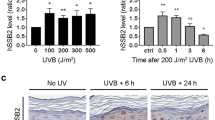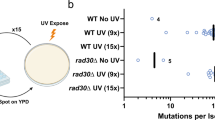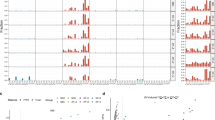Abstract
The apoptotic response and the level of expression of p53 and of three genes transcriptionally activated by p53 (Mdm2, p21 and bax) were investigated in UV-sensitive cells from patients with xeroderma pigmentosum (XP) or Cockayne syndome (CS). These disorders are due to different genetic defects affecting transcription-coupled repair (TCR) and/or global genome repair (GGR), the nucleotide excision repair subpathways which remove UV-induced lesions from the transcribed strand of active genes or from the rest of the genome, respectively. After 20 J/m2 UV light, normal and GGR-defective XP-C fibroblasts showed rapid increase in p53, late induction of Mdm2 and no evidence of apoptosis even 96 h after irradiation. In contrast, in XP-A (defective in GGR and TCR), CS-A and CS-B (defective only in TCR) fibroblasts, the p53 increase was not followed by Mdm2 induction and the persistence of high levels of p53, due to the lack of its degradation by Mdm2, was associated with the appearance of apoptosis. Besides indicating that the persistence of DNA damage in the transcribed strand of active genes leads to apoptosis, these findings provide the first evidence that the lack of activation of Mdm2 plays a key role in the cascade of events leading to apoptosis.
This is a preview of subscription content, access via your institution
Access options
Subscribe to this journal
Receive 50 print issues and online access
$259.00 per year
only $5.18 per issue
Buy this article
- Purchase on Springer Link
- Instant access to full article PDF
Prices may be subject to local taxes which are calculated during checkout







Similar content being viewed by others
References
Barrett SF, Robbins JH, Tarone RE and Kraemer KH . 1991 Mutat Res 255: 281–291
Blattner C, Bender K, Herrlich P and Rahmsdorf HJ . 1998 Oncogene 16: 2827–2834
Bootsma D, Kraemer KH, Cleaver J and Hoeijmakers JHJ . 1998 The Genetic Basis of Human Cancer Vogelstein B and Kinzler KW eds McGraw-Hill New York pp 245–274
Bottger A, Bottger V, Sparks A, Liu WL, Howard SF and Lane DP . 1997 Curr Biol 7: 860–869
Chavanne F, Broughton BC, Pietra D, Nardo T, Browitt A, Lehmann AR and Stefanini M . 2000 Cancer Res 60: 1974–1982
Colella S, Nardo T, Mallery D, Borrone C, Ricci R, Ruffa G, Lehmann AR and Stefanini M . 1999 Hum Mol Genet 8: 935–941
Conforti G, Zanetti A, Colella S, Abbadini M, Marchisio PC, Pytela R, Giancotti F, Tarone G, Languino LR and Dejana E . 1989 Blood 73: 1576–1585
de Laat WL, Jaspers NG and Hoeijmakers JHJ . 1999 Genes Dev 13: 768–785
Dumaz N, Duthu A, Ehrhart JC, Drougard C, Appella E, May P, Sarasin A and Daya-Grosjean L . 1997 Mol Carcinogen 20: 340–347
Dumaz N, Drougard C, Quilliet X, Mezzina M, Sarasin A and Daya-Grosjean L . 1998 Carcinogenesis 19: 1701–1704
Evans MK and Bohr VA . 1994 Mutat Res 314: 221–231
Ford JM and Hanawalt PC . 1995 Proc Natl Acad Sci USA 92: 8876–8880
Ford JM and Hanawalt PC . 1997 J Biol Chem 272: 28073–28080
Freedman DA, Wu L and Levine AJ . 1999 Cell Mol Life Sci 55: 96–107
Haupt Y, Maya R, Kazaz A and Oren M . 1997 Nature 387: 296–299
Hwang BJ, Ford JM, Hanawalt PC and Chu G . 1999 Proc Natl Acad Sci USA 96: 424–428
Kubbutat MH and Vousden KH . 1997 Mol Cell Biol 17: 460–468
Kubbutat MH, Jones SN and Vousden H . 1997 Nature 387: 299–303
Leadon SA . 1999 Am J Hum Genet 64: 1259–1263
Li R, Hannon GJ, Beach D and Stillman B . 1996 Curr Biol 6: 189–199
Ljungman M and Zhang F . 1996 Oncogene 13: 823–831
Ljungman M, Zhang F, Chen F, Rainbow AJ and McKay BC . 1999 Oncogene 18: 583–592
McKay BC, Ljungman M and Rainbow AJ . 1998 Oncogene 17: 545–555
McKay BC, Ljungman M and Rainbow AJ . 1999 Carcinogenesis 20: 1389–1396
Midgley CA and Lane DP . 1997 Oncogene 15: 1179–1189
Miyashita T and Reed JC . 1995 Cell 80: 293–299
Momand J, Zambetti GP, Olson DC, George D and Levine AJ . 1992 Cell 69: 1237–1245
Pan ZQ, Reardon JT, Li L, Flores-Rozas H, Legerski R, Sancar A and Hurwitz J . 1995 J Biol Chem 270: 22008–22016
Parris CN and Kraemer KH . 1993 Proc Natl Acad Sci USA 90: 7260–7264
Smith ML, Chen IT, Zhan Q, Bae I, Chen CY, Gilmer TM, Kastan MB and Fornace Jr AJ . 1994 Science 266: 1376–1380
Stefanini M, Lagomarsini P, Arlett CF, Marinoni S, Borrone C, Trevisan G, Cordone G and Nuzzo F . 1986 Human Genet 74: 107–112
Stefanini M, Giliani S, Nardo T, Marinoni S, Nazzaro V and Rizzo R . 1992 Mutat Res 273: 119–125
Stefanini M, Lagomarsini P, Giliani S, Nardo T, Botta EP, Kleijer WJ, Lehmann AR and Sarasin A . 1993 Carcinogenesis 14: 1101–1105
Stefanini M, Fawcett H, Botta E, Nardo T and Lehmann AR . 1996 Human Genet 97: 418–423
Sugasawa K, Ng JM, Masutani C, Iwai S, van der Spek PJ, Eker AP, Bootsma D and Hoeijmakers JHJ . 1998 Mol Cell 2: 223–232
Tornaletti S and Hanawalt PC . 1999 Biochimie 81: 139–146
van Gool AJ, van der Horst GTJ, Citterio E and Hoeijmakers JHJ . 1997 EMBO J 16: 4155–4162
Wang XW, Forrester K, Yeh H, Feitelson MA, Gu JR and Harris CC . 1994 Proc Natl Acad Sci USA 91: 2230–2234
Wani MA, Zhu QZ, El-Mahdy M and Wani AA . 1999 Carcinogenesis 20: 765–772
Wasylyk C, Salvi R, Argentini M, Dureuil C, Delumeau I, Abecassis J and Wasylyk B . 1999 Oncogene 18: 1921–1934
Xiao H, Pearson A, Coulombe B, Truant R, Zhang S, Regier JL, Reinberg D, Flores O, Ingles CJ and Greenblatt J . 1994 Mol Cell Biol 14: 7013–7024
Yamaizumi M and Sugano T . 1994 Oncogene 9: 2775–2784
Acknowledgements
The authors thank Dr AI Scovassi for insightful discussions. This work was supported in part by Telethon grant E.550 to M Stefanini and by AIRC grants to M Stefanini and M D'Incalci.
Author information
Authors and Affiliations
Rights and permissions
About this article
Cite this article
Conforti, G., Nardo, T., D'Incalci, M. et al. Proneness to UV-induced apoptosis in human fibroblasts defective in transcription coupled repair is associated with the lack of Mdm2 transactivation. Oncogene 19, 2714–2720 (2000). https://doi.org/10.1038/sj.onc.1203583
Received:
Revised:
Accepted:
Published:
Issue Date:
DOI: https://doi.org/10.1038/sj.onc.1203583
Keywords
This article is cited by
-
DNA damage and the balance between survival and death in cancer biology
Nature Reviews Cancer (2016)
-
Suppression of UV-induced apoptosis by the human DNA repair protein XPG
Cell Death & Differentiation (2006)
-
Transcription — guarding the genome by sensing DNA damage
Nature Reviews Cancer (2004)
-
Lack of functional pRb results in attenuated recovery of mRNA synthesis and increased apoptosis following UV radiation in human breast cancer cells
Oncogene (2002)
-
P53 plays a protective role against UV- and cisplatin-induced apoptosis in transcription-coupled repair proficient fibroblasts
Oncogene (2001)



